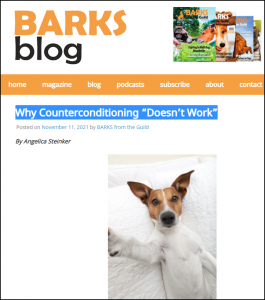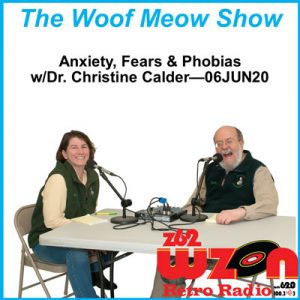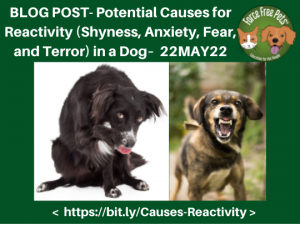 < Updated 22MAY22 >
< Updated 22MAY22 >
< A short link for this page – https://bit.ly/Causes-Reactivity >
Reactivity in a dog is one of the most common reasons I see clients with behavioral concerns about their dog. Frequently, this is triggered by fear. Fear occurs on a continuum from mild shyness or timidity to anxiety, fear, and ultimately terror. Reactivity can also be caused by frustration, anger, and rage,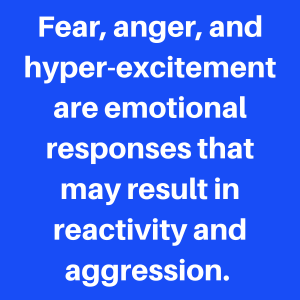 another continuum. Even positive stress, or eustress, such as happiness that leads to hyper-excitement, may cause undesirable reactivity. Fear, anger, and hyper-excitement are emotional responses that may result in reactivity and aggression. While what we call “dog training” can work well for teaching a dog to respond to a cue like sit or down, emotional responses cannot be “trained” away. When a dog or person is in an extreme emotional state, they are under stress, making learning very difficult, if not impossible. When experiencing this level of stress, the dog is under the influence of the “fight or flight response” and is solely concerned about its survival.
another continuum. Even positive stress, or eustress, such as happiness that leads to hyper-excitement, may cause undesirable reactivity. Fear, anger, and hyper-excitement are emotional responses that may result in reactivity and aggression. While what we call “dog training” can work well for teaching a dog to respond to a cue like sit or down, emotional responses cannot be “trained” away. When a dog or person is in an extreme emotional state, they are under stress, making learning very difficult, if not impossible. When experiencing this level of stress, the dog is under the influence of the “fight or flight response” and is solely concerned about its survival.
A dog can be fearful for many reasons:
Genetics – If either parent were on the fear spectrum, all of their offspring would likely be somewhere on the spectrum. Knowing if either of a dog’s parents  is fearful can be very helpful in determining how and if we can help them. If you have not already done so, I recommend talking to the breeder or the rescue or shelter where you obtained your dog. However, understand they may not have information or may misinterpret what they do know.
is fearful can be very helpful in determining how and if we can help them. If you have not already done so, I recommend talking to the breeder or the rescue or shelter where you obtained your dog. However, understand they may not have information or may misinterpret what they do know.
Medical Conditions – A medical issue can often trigger a sudden behavior change. Pain and any physical or emotional discomfort can cause behavioral changes in pets. Disorders of the nervous, endocrine, reproductive, and gastrointestinal systems can also affect your pet’s behavior.
Tick-borne diseases have become much more prevalent in Maine. A few years ago, we only needed to worry about Lyme disease. Today we also need to be concerned about Anaplasmosis, Babesiosis, Borrelia miyamotoi, Ehrlichiosis, Powassan Encephalitis, and Rocky Mountain Spotted Fever. These diseases can cause changes in behavior, including; anorexia, anxiety, confusion, depression, fatigue, malaise, and other subtle mental disorders. I have experienced this with my dog Muppy who has had Lyme disease and anaplasmosis. Both times she exhibited fearful behavior as the only sign of infection. However, once treated by her veterinarian, her behavior returned to normal.
I recommend that a veterinarian rule out any medical issues for fearful behavior before addressing it as a behavioral problem. If your veterinarian does not have experience with treating behavior, I recommend that you see Dr. Christine Calder, a Veterinary Behaviorist practicing in Maine. [ Calder Veterinary Behavior Services, (207) 298-4375, www.caldervbs.com]
Socialization – A puppy has a critical socialization and habituation period that begins when three weeks old and ends between 12 to 16 weeks of age. During this period, a puppy is typically very open to gentle exposure to novel stimuli set up to create a positive association. A puppy should always be given a choice as to whether or not they interact with someone or something. Forced interactions may cause a traumatic experience.
Ideally, you want to carefully expose a puppy to everything it will encounter in its life before they reach 12 to 16 weeks of age. However, if your puppy is acting fearfully during this period, it may be a sign of fear due to a medical issue or genetic issue, in which case I recommend you see your veterinarian immediately.
You can attempt remedial socialization after 16 weeks of age, but it requires a well-thought-out plan. This is not typically a DIY project, and I recommend you seek the services of a credentialed canine behavior consultant or a veterinary behaviorist.
Past or Recent Physical, Mental or Emotional Trauma – A dog’s brain works similar to ours; it is designed to permanently record any distressing experience in one trial to avoid that situation in the future. The next time the dog is exposed to whatever caused the trauma, it may try to flee, freeze in place, or fight if they have no other choice.
Trauma can be physical or emotional. It is vital to understand that only the dogs’ perception matters. In other words, while we might believe that something is not scary or painful, if our dog does find that “something” causes discomfort or is frightening, that is the reality from their perspective. This is a time when our opinion does not matter.
The problem with helping our dog get past a traumatic event is that we may not even know when it occurred, and the dog has no way to tell us. Nor can our dog provide us with any details about the event. For example, suppose your dog is reactive to a specific individual. It could be due to their appearance, behavior, scent, or sounds they made. It could even be due to something in the environment which your dog associated with the individual. As you can see, appearance, behavior, scent, sound, and the environment open up a wide range of possible triggers. What your dog is reacting to may even be a combination of several things, further complicating matters.
Unfortunately, we may never know what our dog fears unless we witness the triggering event. For example, my first dog suddenly became afraid of her water dish and would not drink from it or approach it. Fortunately, I did witness what happened. It was winter, and the air in our home was very dry. We were all in the living room, where the floor was covered with a thick shag carpet. My dog ran along the carpet to her steel water bowl, which was at the edge of the carpet in the dining room, which was not carpeted. She lowered her head to get a drink which caused her to yelp and run away back into the living room. I walked across the carpet, bent down to look at the bowl, touched it, and received a static shock. It was not something I was expecting, but it clearly explained why my dog was suddenly afraid of her dish. Fortunately, I got her drinking again by switching to a non-metal dish and placing it in another location. However, suppose I had not seen that incident in its entirety. In that case, I might never have determined why Trivia suddenly became afraid of her water bowl.
Thunderstorms can be a traumatic event for some dogs creating a lifelong fear. We presume they are reacting to the thunder or lightning, but that is not always the case. Some dogs start reacting before they hear thunder or see a lightning bolt. For example, a friend had a dog who became afraid of storms when they lived in a home struck by lightning. After that, a clap of thunder or bolt of lightning caused the dog to run to the basement. However, over time the dog’s fear generalized to other typical things that occur during a thunderstorm, such as trees blowing in the wind. Therefore, it is essential to understand that any fear can generalize beyond the initial trigger.
Some of the more typical traumas experienced by dogs include;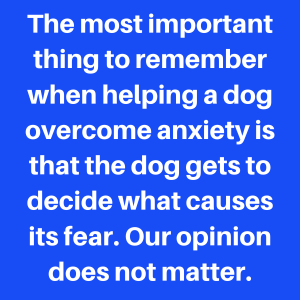
- Physical injury such as a fall, being hit by a car or being bitten by another animal.
- Physical abuse such as being hit or kicked by a person or being subjected to training methods and tools designed to force compliance through pain such as shock, prong, or choke collars.
- Emotional trauma is often associated with physical injuries and abuse. However, even yelling at a dog has the potential to create an unforgettable fear. Likewise, even angry body language expressed by a person can create emotional trauma.
Not all incidents of physical or emotional trauma will cause fear. Whether or not it does depends on the event, the individual dog, and its previous history.
The most important thing to remember when helping a dog overcome anxiety is that the dog gets to decide what causes its fear. Our opinion does not matter.
Addressing Fear – The first two steps in determining why your dog is fearful are; ruling out any potential genetic or medical issues. Neither training nor behavior modification will be helpful until the medical issues are resolved.
The third step is to manage the dog and its environment to prevent exposure to anything that could trigger their fear. In my experience, a well-designed behavior modification protocol and appropriate behavioral medications are almost always necessary when treating anxiety and aggression.
Recommended Resources
Help! My Dog is Aggressive, Reactive, Fearful, Anxious, etc. – What do I do? – http://bit.ly/HelpDogAggx
How Can I Tell When My Dog Is Anxious or Fearful? – http://bit.ly/DogsSignsofFear
Essential Handouts On Body Language, and Canine and Human Behavior from Dr. Sophia Yin – https://bit.ly/YinBodyLang
Shared Blog Post – Reactivity Misunderstood – https://bit.ly/ReactivityMisunderstood
Shared Blog Post – the misunderstanding of time by Nancy Tanner – http://blog.greenacreskennel.com/2016/11/16/shared-blog-post-the-misunderstanding-of-time-by-nancy-tanner/
What Is A Pet Behavior Consultant? – http://bit.ly/WhatIsPetBhxConsulting
Understanding, Identifying and Coping with Canine Stress – http://bit.ly/Canine-Stress
The emotional toll of a reactive dog by Jay Gurden in Dog’s Today – http://bit.ly/SharedGurenEmotional
Canine Behavior: Myths & Facts – http://blog.greenacreskennel.com/2016/03/27/podcast-canine-behavior-myths-and-facts/
Pet Behavior, Vets & The AAHA Canine and Feline Behavior Management Guidelines with Dr. Dave Cloutier from Veazie Veterinary Clinic – http://blog.greenacreskennel.com/2016/03/13/podcast-the-woof-meow-show-pet-behavior-vets-the-aaha-canine-and-feline-behavior-management-guidelines-with-dr-dave-cloutier-from-veazie-veterinary-clinic/
Dog Training Questions for Don and Kate with special guest host Dr. Mark Hanks – part 3 – http://blog.greenacreskennel.com/2015/07/27/blog-post-27jul15-podcast-dog-training-questions-for-don-and-kate-with-special-guest-host-dr-mark-hanks-part-3/
The Unintended Consequences of Shock Collars – http://bit.ly/ShockPodcast
The Pet Professional Guild and the Shock-Free Coalition with Niki Tudge – http://bit.ly/PodCastShockFree-NikiTudge-2017
What’s Shocking About Shock – What Science Tells Us About the Use of Shock in Dog Training – http://bit.ly/WfMw-WhatShock-27JUL19
Podcast – Charlee and the Electronic Shock Containment System w-Dan Antolec – https://bit.ly/Blog-Charlee_E-Fence
To Find A Qualified and Credential Animal Behavioral Specialist
American College of Veterinary Behaviorists (ACVB) – https://www.dacvb.org/search/custom.asp
Animal Behavior Society ( ABS ) Certified Applied Animal Behavior Consultants – http://www.animalbehaviorsociety.org/web/applied-behavior-caab-directory.php
Pet Professional Accreditation Board (PPAB) – https://www.credentialingboard.com/Professionals
________________________________________________________________________
Don Hanson lives in Bangor, Maine, where he is the co-owner of the Green Acres  Kennel Shop ( greenacreskennel.com ) and the founder of ForceFreePets.com, an online educational resource for people with dogs and cats. He is a Professional Canine Behavior Consultant (PCBC-A) accredited by the Pet Professional Accreditation Board (PPAB) and a Bach Foundation Registered Animal Practitioner (BFRAP). Don is a member of the Pet Professional Guild (PPG), where he serves on the Board of Directors and Steering Committee and chairs the Advocacy Committee. He is also a founding director of Pet Advocacy International (PIAI). In addition, Don produces and co-hosts The Woof Meow Show podcast, available at http://bit.ly/WfMwPodcasts/, the Apple Podcast app, and Don’s blog: www.words-woofs-meows.com. The opinions in this post are those of Don Hanson.
Kennel Shop ( greenacreskennel.com ) and the founder of ForceFreePets.com, an online educational resource for people with dogs and cats. He is a Professional Canine Behavior Consultant (PCBC-A) accredited by the Pet Professional Accreditation Board (PPAB) and a Bach Foundation Registered Animal Practitioner (BFRAP). Don is a member of the Pet Professional Guild (PPG), where he serves on the Board of Directors and Steering Committee and chairs the Advocacy Committee. He is also a founding director of Pet Advocacy International (PIAI). In addition, Don produces and co-hosts The Woof Meow Show podcast, available at http://bit.ly/WfMwPodcasts/, the Apple Podcast app, and Don’s blog: www.words-woofs-meows.com. The opinions in this post are those of Don Hanson.
©22MAY22, Donald J. Hanson, All Rights Reserved
< Click for Copyright and Use Policy >
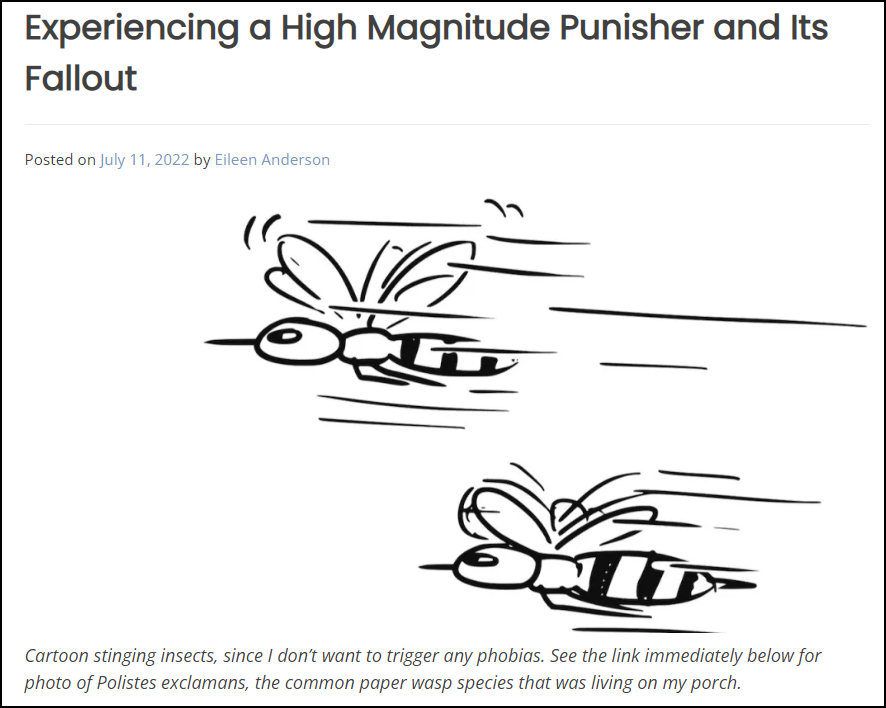 In her blog post of July 11th, 2022, Eileen Anderson of EileenandDogs describes how unexpectedly getting stung by a wasp dramatically changed her behavior. I have shared Eileen’s post on my blog because this same type of response can occur when our pets experience something they find punishing. Understand that what they experienced may not seem traumatic to you; however, how you perceived the incident is irrelevant if the injured party found the experience traumatic. Mammalian brains are designed to remember traumatic events FOREVER so we can avoid being hurt again. This is a deep-seated emotional response and typically cannot just be “trained away.” If you find your dog is suddenly afraid, you may better understand how they feel after reading Eileen’s post.
In her blog post of July 11th, 2022, Eileen Anderson of EileenandDogs describes how unexpectedly getting stung by a wasp dramatically changed her behavior. I have shared Eileen’s post on my blog because this same type of response can occur when our pets experience something they find punishing. Understand that what they experienced may not seem traumatic to you; however, how you perceived the incident is irrelevant if the injured party found the experience traumatic. Mammalian brains are designed to remember traumatic events FOREVER so we can avoid being hurt again. This is a deep-seated emotional response and typically cannot just be “trained away.” If you find your dog is suddenly afraid, you may better understand how they feel after reading Eileen’s post.





